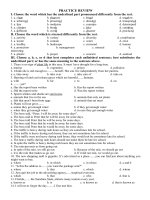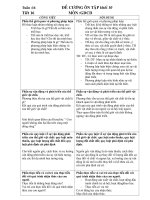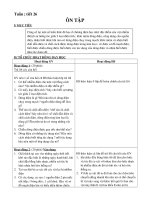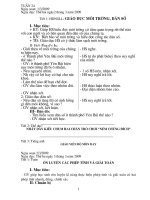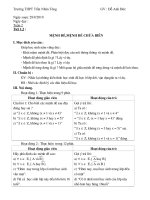GA ON TAP 10
Bạn đang xem bản rút gọn của tài liệu. Xem và tải ngay bản đầy đủ của tài liệu tại đây (134.03 KB, 14 trang )
<span class='text_page_counter'>(1)</span><div class='page_container' data-page=1>
Date of preparing:
Date of teaching:
Class:
10 A
Attendance:
10 C
Attendance:
10 D1
Attendance:
10 D2
Attendance:
Period 101
st<b>REVIEW LESSON 1</b>
<b>I. Objectives</b>
<i><b>1. Aims: By the end of the lesson, Ss will be able to</b></i>
- Master the use of Conditional Types 2 and 3 and The Passive voice.
<i><b>2. Knowledge: </b></i>
<i><b>- Grammar: </b></i>
+ Conditional Types 2 and 3
+ The Passive voice.
<i><b>3. Skills: Reading Speaking, listening, writing.</b></i>
<b>II. Methods</b>
: Integrated, mainly communicative.
<b>III. Teaching aids</b>
: Textbook, lesson plan and workbook.
<b>IV. Procedure:</b>
1. Greeting and checking Ss’ attendance.
2. Checking: Asks Ss to do exercises.
</div>
<span class='text_page_counter'>(2)</span><div class='page_container' data-page=2>
<i><b>Teacher’s activities</b></i>
<i><b>Students’ activities</b></i>
<b>I. Presentation</b>
- T gets Ss to review the form,
meaning and use of Conditional
sentences type 2 & 3 and The
Passive voice.
<b>1. Conditional sentences types 2 </b>
<b>& 3</b>
- T elicits the form, meaning and
use of Conditional sentences type 2
from Ss.
- T elicits the form, meaning and
use of Conditional sentences type 2
from Ss.
- T elicits the form, meaning and
use of Conditional sentences type 3
- Review the form, meaning and use of
Conditional sentences type 2 & 3 and
The Passive voice.
- Review the form, meaning and use of
Conditional sentences type 2 & 3
<b>a. Conditional sentence type 2:</b>
<b>1. Form:</b>
If S+V(past tense) , S+ would/could
+V(bare infi)
<b>2. Meaning: </b>
<i>Conditional sentence type 2 is used to </i>
<i>express things or action that are unreal </i>
<i>(not true or not possible) in the present </i>
<i>or in the future.</i>
<b>3. Use</b>
: Conditional sentence type 2 is
<i>used to talk about thing that can not </i>
<i>happen in the present or future.</i>
<b>Note</b>
: Be = were (for all subjects)
<b>b. Conditional sentence type 3:</b>
<b>1. Form: </b>
</div>
<span class='text_page_counter'>(3)</span><div class='page_container' data-page=3>
from Ss.
- T gets Ss to make examples with
these conditional sentences.
<b>2. The passive voice:</b>
- T elicits the form, meaning and
use of the passive voice.
- Ask Ss to give examples of active
and passive voices.
would/could have + V( PII)
<b>2. Meaning and use</b>
: The third
<i>conditional is used to talk about unreal </i>
<i>situation in the past. In other words, it is</i>
<i>used to talk about things which DID </i>
<i>NOT HAPPEN in the past or to express </i>
<i>regrets.</i>
- Give examples with conditional
sentences.
Examples:
<i>1. If I had had the money, I would have </i>
<i>bought that motorbike.</i>
<i>2. If she had studied hard, she would not</i>
<i>have failed the exam.</i>
- Give out the form, meaning and use of
the passive voice.
<b>+ Form:</b>
AV: S + V + O
PV: S + be+ Vpast participle + by O
<b>+ Meaning:</b>
Passive voice
<b>+ Use:</b>
The passive voice is used when
we want to focus on what happening, not
who or what did it.
</div>
<span class='text_page_counter'>(4)</span><div class='page_container' data-page=4>
- T asks Ss to gives out the form of
active voice and then translate into
the passive voice of all verb tenses
they have learnt.
II. Practice
- T gives Ss some exercises for
practicing.
- Give out the form of active voice
and then translate into the passive
voice of all verb tenses they have
learnt.
- Do the exercises.
4. Consolidation: Summarize the main points of the lesson.
</div>
<span class='text_page_counter'>(5)</span><div class='page_container' data-page=5>
Date of preparing:
Date of teaching:
Class:
10 A
Attendance:
10 C
Attendance:
10 D1
Attendance:
10 D2
Attendance:
Period 102
nd<b>REVIEW LESSON 2</b>
<b>I. Objectives</b>
<i><b>1. Aims: Review all the grammar that Ss have learnt.</b></i>
<i><b>2. Knowledge: </b></i>
<i><b>- Grammar: </b></i>
+ Wh-questions
+ Attitudinal adjectives
+ It is/was not until…….that………..
<i><b>3. Skills: Reading Speaking, listening, writing.</b></i>
<b>II. Methods</b>: Integrated, mainly communicative.
<b>III. Teaching aids</b>: Textbook, lesson plan and workbook.
<b>IV. Procedure:</b>
</div>
<span class='text_page_counter'>(6)</span><div class='page_container' data-page=6>
<i><b>Teacher’s activities</b></i> <i><b>Students’ activities</b></i>
<b>I. Presentation</b>
- T asks Ss to review
+ Wh-questions
+ Attitudinal adjectives
+ It is/was not until…….that………..
<b>1. </b>
<b> </b>
<b>Wh-questions</b>
- Ask Ss to revise the kinds of
Wh-questions, form of Wh-questions
- T gives Ss some examples.
- T asks Ss to give some more examples
-
Review:+ Wh-questions
+ Attitudinal adjectives
+ It is/was not until…….that………..
- Give out the kinds of
Wh-questions,
form of Wh-questions
<b>*. Kinds of Wh-questions: </b>
What?: Object/ Idea/ Action
Where?: Place
When?: Time
Why? : Reason
Who? Person
How?
How long?
How far?
How many + Ns?
How much + U.N?
How much ( Price)?
<b>* Form:</b>
<i>Wh-questions + Auxi V + S + V?</i>
- Study T’s examples and then note them
down.
Examples:
She was eating a sandwich What was
she eating?
She talked to him for an hour. How long
</div>
<span class='text_page_counter'>(7)</span><div class='page_container' data-page=7>
<b>2. Attitudinal adjectives</b>
- T reviews the Attitudinal adjectives
for Ss.
- T also explains the difference of some
verbs that have two possible adjectival
forms, the –ing form and the-ed form
- T gives Ss some examples.
- T asks Ss to give some more
examples
<b>3. It is/was not until…that…</b>
- T explains the form, meaning and use of
the structure “ It was not until…that…” for
Ss.
- T gets Ss to translate some English
sentences into Vietnamese.
<i>+ It was not until last year that this shool </i>
<i>was built.</i>
<i>+ It was not until i was 15 that </i>
<b>II. Practice</b>
- T asks Ss to do related exercises.
- T gets Ss to do the exercises individually
and then compare with partner.
-
give some more examples
- Revise the
Attitudinal adjectives
- Study the difference of some verbs that
have two possible adjectival forms, the –ing
form and the-ed form.
<i>+ The –ing form has an active meaning.</i>
<i>+ The –ed form has a passive meaning.</i>
- Study examples
-
give some more examples
- Study the form, meaning and use of the
structure “ It was not until…that…”.
- Translate the sentences into Vietnamese.
- Do exercises
- Do the exercises individually and then
compare with a partner.
4. Consolidation: Summarize the main points of the lesson.
</div>
<span class='text_page_counter'>(8)</span><div class='page_container' data-page=8>
Date of preparing:
Date of teaching:
10 A
Attendance:
10 C
Attendance:
10 D1
Attendance:
10 D2
Attendance:
Period 103
rd<b>REVIEW LESSON 3</b>
<b>I. Objectives</b>
<i><b>1. Aims: </b></i>
Review all the grammar that Ss have learnt.
<i><b>2. Knowledge: </b></i>
<i><b>- Grammar: </b></i>
+ A/An and The
+ Will and Be going to
+ Non-defining and defining relative clauses.
<i><b>3. Skills: Reading Speaking, listening, writing.</b></i>
<b>II. Methods: Integrated, mainly communicative.</b>
<b>III. Teaching aids: Textbook, lesson plan and workbook.</b>
<b>IV. Procedure:</b>
</div>
<span class='text_page_counter'>(9)</span><div class='page_container' data-page=9>
<i><b>Teacher’s activities</b></i> <i><b>Students’ activities</b></i>
<b>I. Presentation</b>
- T reviews
+ A/An and The
+ Will and Be going to
+ Non-defining and defining relative
clauses.
<b>1. A/An and The</b>
- T reviews the form, meaning and use of
A/An and The for Ss.
- T asks Ss to give some examples of A/ An
and The.
<b>2. Will and Be going to</b>
- T writes on the board some examples
containing both “will” and “ going to”.
<b>E.g.:</b>
<i>1. Why are you working so hard these days?</i>
<i>+ Because I’m going to buy a car so I’m </i>
<i>saving as much as I can.</i>
<i>2. What are you going to buy Jill for her </i>
<i>birthday?</i>
<i>+ A CD.</i>
<i>+ She hasn’t got a CD player.</i>
<i>+ Oh, I will buy her a record then.</i>
- T gets Ss to explain why “going to” but
not “will” is used in example 1 and “will”
but not “going to” in the example 2.
- T gets the answers from Ss and then
explains again the form, meaning and use of
“ will” and “going to” for Ss.
-
Review+ A/An and The
+ Will and Be going to
+ Non-defining and defining relative
clauses.
- Review A/An and The.
- Give some examples of A/ An and The.
- Observe T’s examples on the board.
- Explain the differences between “will”
and “ going to”.
- Study the form, meaning and use of “ will”
and “going to” again.
<i><b>* Will:</b></i>
<b>+ Form:</b>
<i>(+) S + WILL + V-inf</i>
</div>
<span class='text_page_counter'>(10)</span><div class='page_container' data-page=10>
- T gives Ss examples to make sure that Ss
understand the differences between the two
structures.
<b>3. Non-defining and defining relative </b>
<b>clauses.</b>
- T gets Ss to read the example in the
textbook and then explains the form,
meaning and use of non-defining and
defining relative clause with “which”.
Example:
<i><b>-New York Harbour</b></i><b>, which is ice-free </b>
<b>in all seasons, </b><i><b>is one of the largest and </b></i>
<i><b>finest habours in the world.</b></i>
<b>+ Meaning</b>: <i>Future</i>
<b>+ Use:</b><i>WILL is used to express a future </i>
<i>intention or decision made at the moment of</i>
<i>speaking.</i>
<i><b>* Going to:</b></i>
<b>+ Form:</b>
<i>(+) S + am/is/are + going to + V-inf</i>
<i>(-) S+am/is/are +not + going to +V-inf</i>
<i>(?) Am/Is/Are + S + going to + V-inf?</i>
<b>+ Meaning :</b><i>Future</i>
<b>+ Use:</b><i>“Going to” is used to express a </i>
<i>future intention or decision thought about </i>
<i>before the moment of speaking.</i>
<b>E.g.:</b>
<i>+ Oh, we’ve run out of milk. I’ll go and buy </i>
<i>it now.</i>
<i>+ I heard you and John are going to get </i>
<i>married. Congratulations!</i>
- Read the example and then study the form,
meaning and use of non-defining and
defining relative clause with “which”.
<b>1. Form:</b><i>In non-defining relative clause, </i>
<i>we need to place a comma to separate a </i>
<i>non-defining relative clause from the main </i>
<i>clause if it come at the end of the sentence </i>
<i>and two commas if it is inserted within the </i>
<i>sentences. We don’t need a comma in the </i>
<i>case of defining relative clauses.</i>
<b>2. Meaning:</b><i>A clause introduced by a </i>
<i>relative pronoun.</i>
<b>3. Use: </b>
<i>* We use defining relative clauses to give </i>
<i><b>essential information</b> to define or identify </i>
<i>the thing we are talking about. Obviously, </i>
<i>this is only necessary if there is more than </i>
<i>one thing involved.</i>
</div>
<span class='text_page_counter'>(11)</span><div class='page_container' data-page=11>
<b>II. Practice</b>
- T gets Ss to do related exercises to
practice.
<i><b>more information to the things</b> we are </i>
<i>talking about. Without this additional </i>
<i>information, the sentence still makes sense </i>
<i>because it is already clear what things we </i>
<i>are talking about.</i>
- do related exercises to practice.
4
. Consolidation: Summarize the main points of the lesson.</div>
<span class='text_page_counter'>(12)</span><div class='page_container' data-page=12>
Date of preparing:
Date of teaching:
Class:
10 A
Attendance:
10 C
Attendance:
10 D1
Attendance:
10 D2
Attendance:
Period 104
th<b>REVIEW LESSON 4</b>
<b>I. Objectives</b>
<i><b>1. Aims: </b></i>
Review all the grammar that Ss have learnt.
<i><b>2. Knowledge: </b></i>
<i><b>- Grammar: </b></i>
+ Although as a contrasting connector
+ Comparative and superlative
<i><b>3. Skills: Reading Speaking, listening, writing.</b></i>
<b>II. Methods: Integrated, mainly communicative.</b>
<b>III. Teaching aids</b>
: Textbook, lesson plan and workbook.<b>IV. Procedure:</b>
</div>
<span class='text_page_counter'>(13)</span><div class='page_container' data-page=13>
<i><b>Teacher’s activities</b></i> <i><b>Students’ activities</b></i>
<b>I. Presentation</b>
- T reviews:
+ Although as a contrasting connector
+ Comparative and superlative
<b>1. Although as a contrasting connector</b>
- T gets Ss to study the example in the book.
Example:
<b>Although</b> New York is not the capital of
the USA, It is the home of the United
Nations
- T explains the form, meaning and use of
“Although”.
- T gives Ss some examples
- T asks Ss to give some more examples
<b>2. Comparative and superlative</b>
<b>-</b>Give example:
I <i>am taller than Mai</i>
<i>She is more beautiful than her mother</i>
<i>I am the oldest in my family</i>
<i>He is the most intelligent boy in the class</i>
-
Let students give form of Comparativesand superlatives using the above examples
- Review
+ Although as a contrasting connector
+ Comparative and superlative
- Study the example.
- Study the form, meaning and use of
“Although”.
<b>+ Form:</b><i>The subordinate clause with </i>
<i>“although” can come either before or after </i>
<i>the main clause. Don’t use “although” </i>
<i>together with “but”.</i>
<b>+Meaning</b>: <i>in spite of the fact that</i>
<b>+Use:</b><i>We use this conjunction to contrast </i>
<i>ideas.</i>
- Study examples
- Give more examples
- Study the examples
-Listen to the teacher
- Work in their own and compare each other
1.<b>Comparative:</b> ( So sánh hơn )
</div>
<span class='text_page_counter'>(14)</span><div class='page_container' data-page=14>
-Ask students give some examples
<b>II. Practice</b>
T asks Ss to do related exercises to practice
+ S2
Ex1: This book is older than that one.
Ex2: My classroom is bigger than your
classroom/ yours.
b) <i>So sánh hơn của tính từ dài</i>
S1 + to be + more + long adjective + than
+ S2
2.<b>Superlative:</b> ( So sánh nhất )
<i>a)So sánh nhất của tính từ ngắn:</i>
S + to be + THE + short Adjective - EST +
in/ of + N
Ex: Lan is the tallest student in my class.
b) <i>So sánh nhất của tính từ dài</i>
S + to be + THE + most + long Adjective +
in/ of + N
- Write down and give more other sentences
- Do related exercises.
4. Consolidation: Summarize the main points of the lesson.
</div>
<!--links-->


